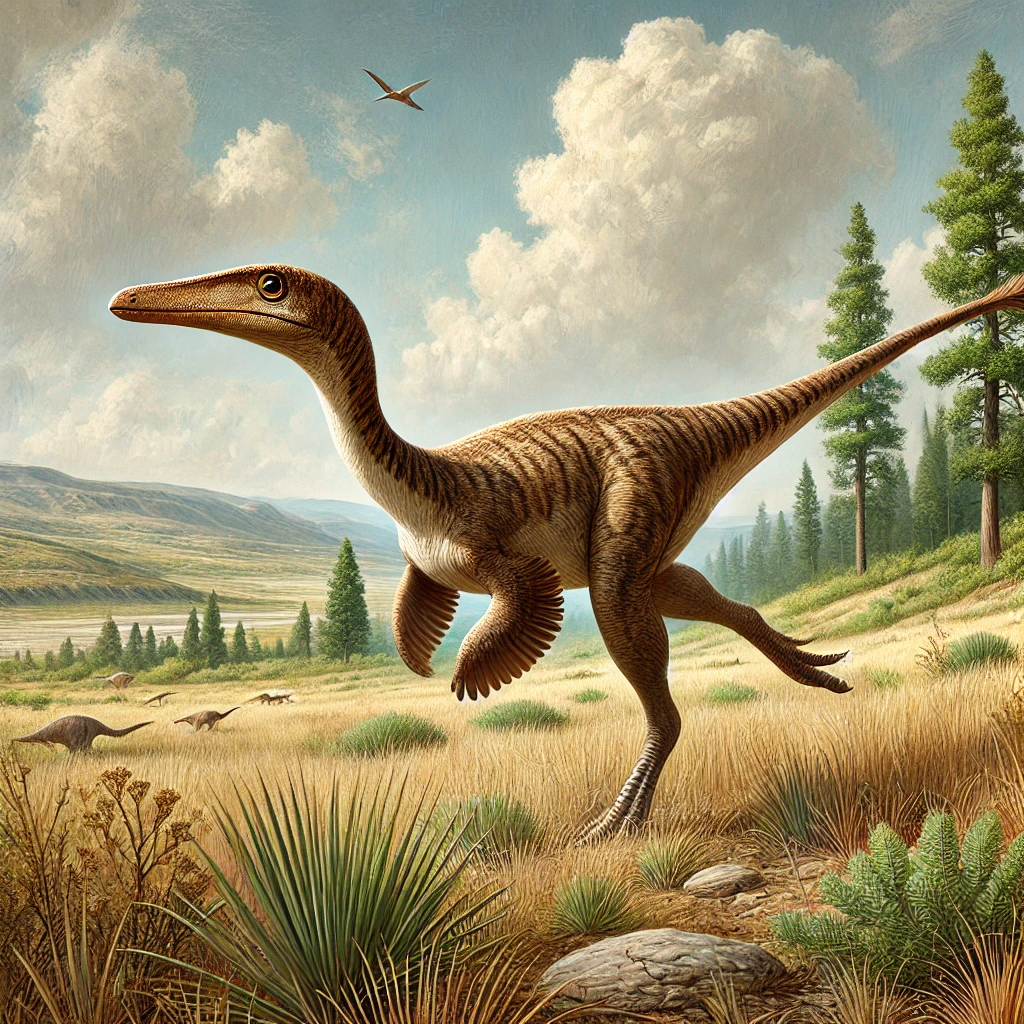Gallimimus
Pronunciation:
Gal-li-my-mus
Name Meaning:
“Chicken mimic”
Dinosaur Classification:
- Kingdom: Animalia
- Phylum: Chordata
- Class: Reptilia
- Order: Saurischia
- Suborder: Theropoda
- Family: Ornithomimidae
- Genus: Gallimimus
- Species: G. bullatus
Dinosaur Description:
Gallimimus was a large, fast-running theropod dinosaur that roamed the Late Cretaceous period about 70 million years ago. Its name, “chicken mimic,” comes from the fact that its build and posture resembled that of modern birds. It belonged to the family Ornithomimidae, which are often called “ostrich dinosaurs” due to their bird-like appearance. With a lightweight body and long, powerful legs, Gallimimus was well-adapted to running, making it one of the fastest dinosaurs of its time.
Gallimimus had a long, slender neck and a small, toothless head with a beak-like mouth. This unique structure suggests that it had a varied diet, possibly feeding on plants, small animals, or even eggs. The large eyes positioned on the sides of its head provided a wide field of vision, which would have been beneficial for spotting predators and prey alike.
Its long tail served as a counterbalance while running, allowing Gallimimus to maneuver swiftly. Fossil evidence points to this dinosaur being a social creature, as several specimens have been found in close proximity, hinting at possible herd behavior. This would have given it protection against larger predators, such as Tyrannosaurus rex, which also lived during the same period.
Unlike many theropods, Gallimimus was not a predator but more likely an omnivore or herbivore, using its beak to forage for food. The lack of teeth and the shape of its beak suggest that it may have grazed on low-lying vegetation or even scoured for insects or small vertebrates.
Gallimimus has often been compared to modern birds, not just in appearance but also in behavior. It may have had feathers during certain stages of its life, although no direct evidence of feathers has been found with Gallimimus fossils. The link between dinosaurs like Gallimimus and modern birds has helped paleontologists understand the evolutionary transition from dinosaurs to birds.
Dinosaur Diet and Behavior:
Gallimimus was likely an omnivore. Its toothless beak suggests that it fed on a variety of plant material, insects, and possibly small animals or eggs. It is also believed that Gallimimus may have lived in herds, offering protection from larger predators. Its speed was likely its greatest defense mechanism, allowing it to escape danger quickly.
Dinosaur Size:
Gallimimus grew up to 20 feet (6 meters) in length, making it one of the larger members of the Ornithomimidae family.
Dinosaur Weight:
Gallimimus weighed approximately 970 pounds (440 kilograms), though its lightweight frame allowed it to be agile and fast.
Fossil Discoveries:
The first Gallimimus fossils were discovered in Mongolia’s Gobi Desert during the 1960s. The species was named Gallimimus bullatus in 1972 by paleontologists Rinchen Barsbold, Halszka Osmólska, and Ewa Roniewicz. Several well-preserved skeletons have been found, allowing paleontologists to reconstruct the dinosaur’s anatomy in great detail. The Gobi Desert remains one of the richest sources of Gallimimus fossils.
What Period Did The Dinosaur Live:
Gallimimus lived during the Late Cretaceous period, around 70 million years ago.
Notable Facts or Trivia:
– Gallimimus is often featured in popular media, including the famous “Jurassic Park” movies, where it is portrayed as a fast-running, herd-dwelling dinosaur.
– Its name, meaning “chicken mimic,” reflects its bird-like appearance and posture.
– Despite being a theropod, Gallimimus was not a typical carnivore and likely had an omnivorous diet.
Scientific Significance:
Gallimimus has been a key dinosaur in understanding the evolutionary relationship between dinosaurs and modern birds. Its bird-like anatomy, especially its beak and lightweight body, has provided insights into how certain theropods may have evolved into birds. Additionally, its fossils have helped scientists learn more about dinosaur behavior, particularly the idea of social or herd behavior among certain species.
Extinction & Legacy:
Like many dinosaurs of the Late Cretaceous period, Gallimimus became extinct during the Cretaceous-Paleogene extinction event around 66 million years ago. However, its legacy lives on in its connection to modern birds. Gallimimus is often referenced in scientific discussions about the transition from dinosaurs to birds, and it remains one of the most well-known dinosaurs due to its unique appearance and frequent depiction in popular media.
